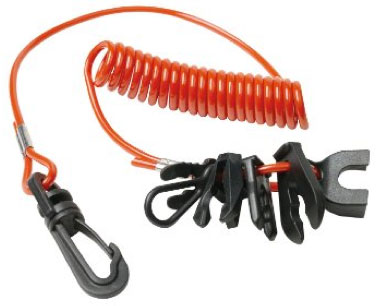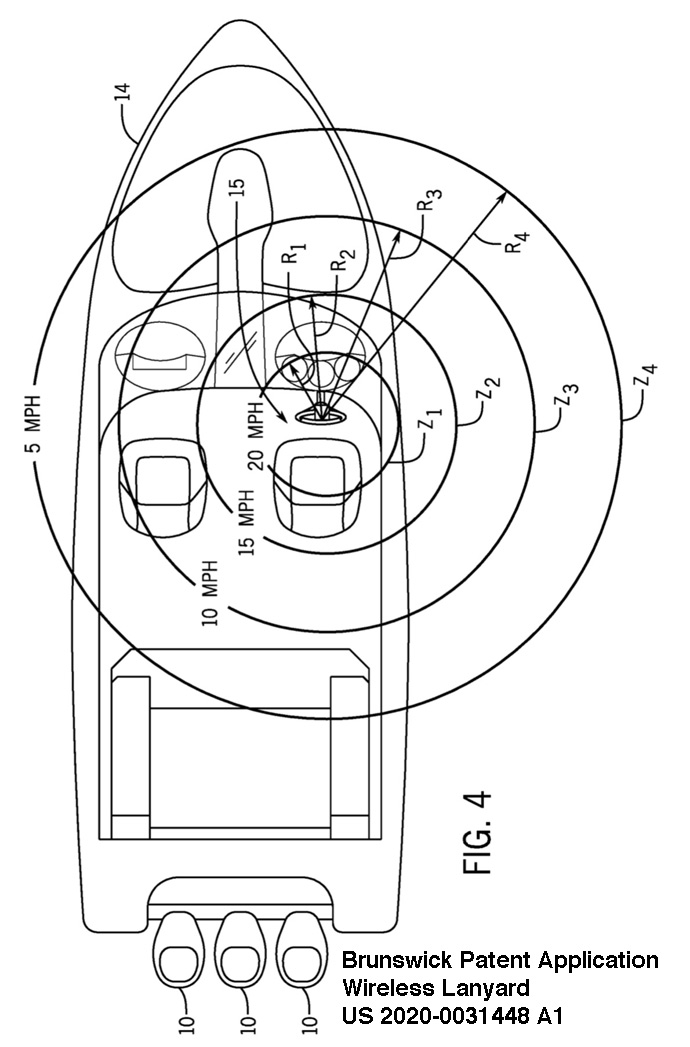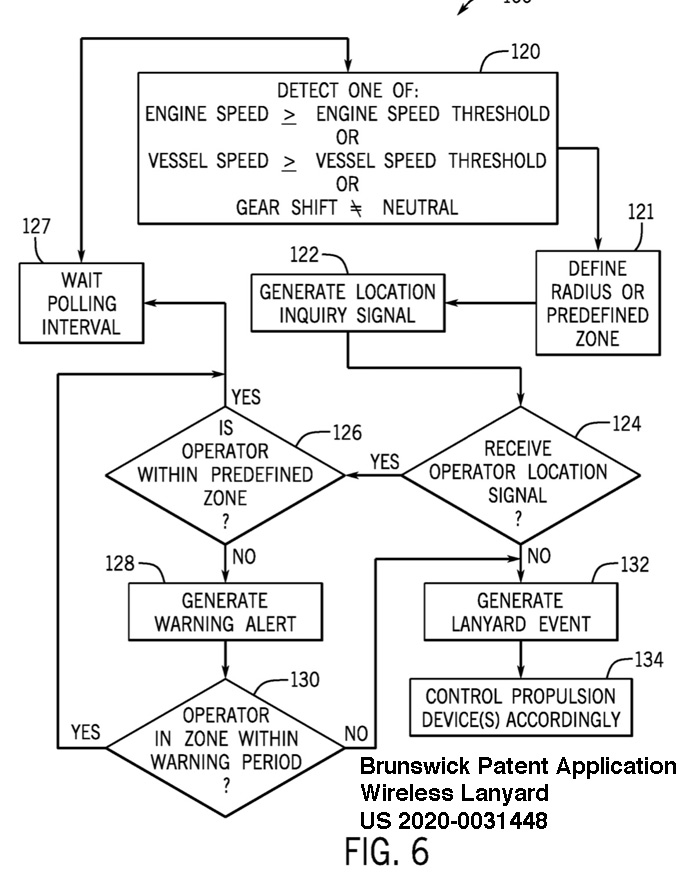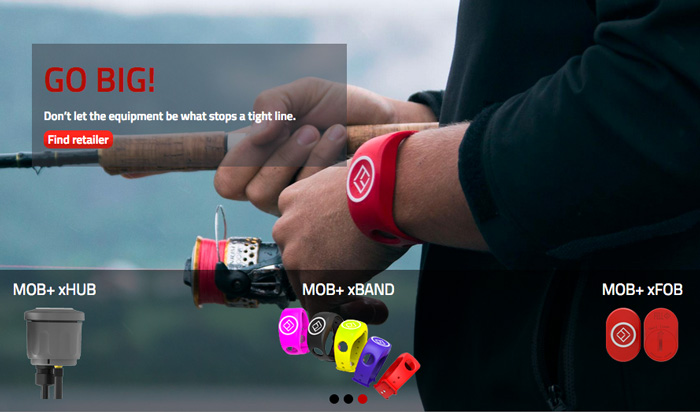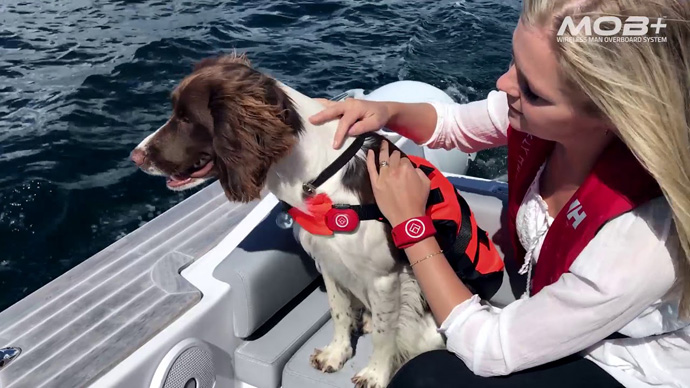Brunswick wireless lanyard patent application
Brunswick’s wireless lanyard is made possible by the combination CANbus systems now used by boats and marine drives in conjunction with data available from the Engine Control Unit (ECU) and today’s digital controls (like digital shift/throttles).
Brunswick’s patent application describes a wireless lanyard that operates automatically. It does not require being turned off or on. The system checks to see if the operator is within a certain range (like within so many feet) of the helm depending on conditions such as is the boat in gear or out of gear, how fast is the boat going, etc. The operator is allowed to range further when the boat is out of gear or moving slowly than when underway at speed.
Similarly, GPS information can be used to identify areas of high boating traffic, areas within a certain distance of shoreline, docks, or bridges and reduce the range the operator can be from the helm in those circumstances. Certain areas can be geofenced and require their own set of conditions.
The system can warn the operator before it slows or stops the boat by blowing a horn and allowing him or her a few seconds to return to the helm. If the operator does not get back within the range within the allotted time, the system can slow the engine, shift to neutral, or kill the engine based on its decision matrix.
Traditional cord lanyards / kill cords abruptly stop the engine while Brunswick’s system provides options for slowing or stopping the boat less likely to cause those standing to fall or fall overboard or be injured when a cord type lanyard is actuated. Brunswick’s wireless lanyard system can even gradually slow the engine down while it is still in gear providing a nice gradual stop as an option.
Additional Features
Brunswick notes traditional cord lanyards can go overboard with the operator. With the operator falling overboard, the engine dead and no cord on board or even if there is another cord on board chaos can ensue. Brunswick’s wireless lanyard invention can shift the engine to neutral and leave it running allowing those remaining on boat to more quickly rescue an operator that fell overboard, reducing chaos and increasing probability of a safe rescue.
Brunswick’s patent refers to the operator being outside the currently described parameters and not returning within a given time after being warned by the system, a lanyard event.
The patent application talks about polling the operator (a fob on the operator) about once a second during certain conditions (such as engine running and in gear) to see if the operator is where they belong. The system can also poll passengers with fobs to make sure they have not fallen overboard. If no signal is found for the operator in certain conditions (like running at speed), the boat will immediately go into an operator overboard mode, it will not sound an alarm waiting a few seconds for the operator to return because they are already overboard.
While the system does not require someone to turn it on, it does require the operator to wear a fob or tag of some sort. We suspect Mercury Marine’s previous teaming with Fell Marine may have something to do with this invention, with the fob, and with the wireless technologies used by the system.
Steven Gonring of Wisconsin is listed as the sole inventor. The patent was assigned to Brunswick Corporation.
The patent application was filed 26 June 2018. The patent has not yet issued.
We are happy to see Brunswick / Mercury Marine talking about limiting actions on the vessel based on GPS location. They also mentioned changing system parameters based on geofencing. We have suggested both methods before with respect to multiple boating safety applications.
In addition to GPS data, the patent leaves open the possibility of using of gyroscope data to determine a heading and attitude sensors to determine running trim, magnetometers, and inertial measuring sensors such a gyroscope, in combination with accelerometers and a magnetometer.
Ranging
Brunswick says the fob could be an active or passive RFID tag or some other technology.
RFID tags are commonly used to determine presence. At first we were a loss as to how Brunswick was determining position using such a tag. Then we saw the mention of inertial measurements in the body of the patent. Inertial measurement GPS techniques were first made popular in the canyons (down at street level in major cities where GPS signals can get to for all the tall buildings in the way as well as inside those tall buildings). While the patent application talks about inertial measurements in the body of its text we do not see it mentioned in the claims or its purpose specifically explained in the text. We suspect they are mentioning it with respect to determining how far the operator is from the helm.
The patent application does mention time of flight (sort of radar like determination of distance, like the old Polaroid ranging kits we used to use) as one option and determining signal strength as another means of ranging the operator. RFID already has some challenges with people and stuff in the way when used to determine presence at the helm or nearby. We suspect trying to determine range as the operator walks around behind people, objects, and even turns around himself will create some serious challenges for ranging to the helm.
Brunswick says similar fobs can be used by passengers as well. The system will alert the operator if a passenger goes overboard.
I thought it was a bit interesting the patent did not specially mention pets (dogs) and children as potential applications of these tags. Dogs, children, and pretty girls are often shown in ads for current wireless lanyards.
Much work has been performed on inertial ranging / positioning of people in areas GPS signals do not work. Those technologies are likely applicable here on a platform very limited in size with a known geography (the boat).
Patents and Standards
Patent applications are normally published 18 months after they have been filed. You can pay extra fees to prevent that publication (keep your invention out of sight til the patent issues if it ever does). Brunswick often pays the extra fees to avoid disclosure by publication at 18 months but did not do so in this case.
ABYC recently reviewed the lanyard kill switch standard again. Some concepts mentioned by Brunswick in this patent application may encounter some challenges with the existing standard but they (ABYC) are already having some challenges with the existing wireless lanyard technologies developing faster than their standards are able to keep up with them.
The boating industry is still struggling a bit with what to call these devices as they refuse to use the phrase “kill switch”. Wireless lanyards is a nice phrase but then they still struggle coming up with a politically correct name for for the rest of the system.
A few years back, Dick Snyder, long time Mercury Marine propeller accident expert witness said Mercury had long made safety technologies they patented available to the industry for use by others. If this patent is actually issued and others desire to use the technology, we will see what happens.
Congratulations Brunswick & Mercury Marine
Congratulations to Brunswick and Mercury Marine for their efforts at wrapping existing available technologies together to create of new wireless lanyard with options not previously available. The availability of their CANbus system, ECU controls, GPS, digital shift/throttle, and sensors of many types bring all kinds of opportunities such as those recently seen with joystick positioning, automatic docking, gps anchoring, automatic trim, digital anchoring maintaining a heading, and many more yet to come. We encourage Brunswick to continue to innovating safety systems based on these opportunities.
